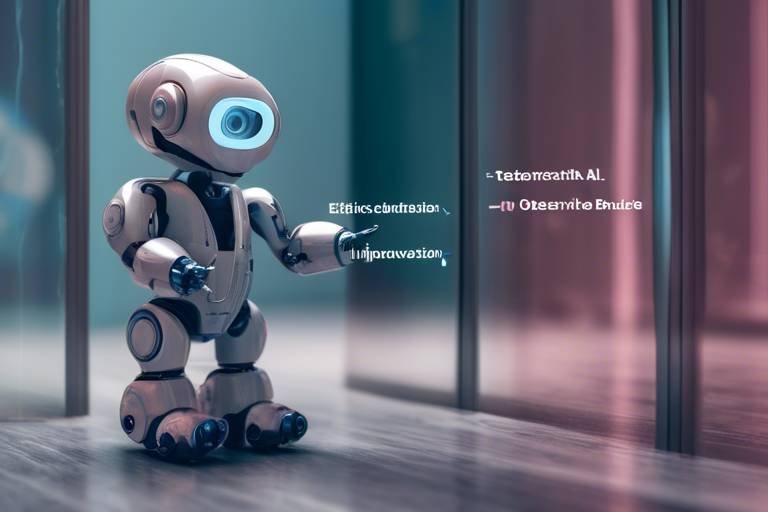Developing a Strategic Approach to AI Ethics
In today's rapidly evolving technological landscape, the emergence of Artificial Intelligence (AI) has brought forth not only groundbreaking advancements but also a plethora of ethical dilemmas. As we integrate AI into various sectors—ranging from healthcare to finance—it's imperative to establish a strategic framework for AI ethics. This framework will guide the development and deployment of AI technologies, ensuring they align with our societal values while promoting accountability, fairness, and transparency.
Imagine AI as a double-edged sword; it has the potential to revolutionize our lives, yet it also poses significant risks if not handled with care. The question arises: how do we harness this power responsibly? A strategic approach to AI ethics serves as a roadmap, helping organizations navigate the complex landscape of ethical considerations associated with AI. This involves not just understanding the ethical principles at play but also actively implementing practices that mitigate risks and enhance trust among users and stakeholders.
To develop an effective strategic approach, organizations must first recognize the importance of collaboration. Engaging with diverse stakeholders—including ethicists, technologists, and community representatives—ensures that multiple perspectives are considered in the decision-making process. This collaborative effort can lead to the creation of more inclusive AI systems that reflect the needs and values of the broader society. Additionally, organizations should prioritize ongoing education and training on AI ethics for their teams, fostering a culture of awareness and responsibility.
Furthermore, a strategic approach to AI ethics should include robust mechanisms for monitoring and evaluation. This involves establishing clear metrics to assess the ethical implications of AI applications and ensuring that these metrics are regularly reviewed and updated. By doing so, organizations can proactively identify potential ethical pitfalls and address them before they escalate into larger issues.
As we look towards the future, it's crucial for organizations to stay informed about the evolving landscape of AI ethics and regulations. By actively engaging with policymakers and participating in discussions about ethical standards, organizations can help shape a future where AI technologies are developed and deployed responsibly. In this way, we can ensure that AI serves as a force for good, enhancing our lives while respecting our fundamental rights and values.
- What are the main ethical principles in AI?
The core ethical principles include fairness, accountability, and transparency, which guide the development of AI technologies. - How can organizations ensure fairness in AI?
Organizations can ensure fairness by implementing diverse data representation and conducting regular bias audits. - What role do regulations play in AI ethics?
Regulations help shape ethical standards and ensure that AI technologies align with societal expectations. - Why is stakeholder engagement important in AI ethics?
Engaging stakeholders ensures that multiple perspectives are considered, leading to more inclusive and responsible AI systems.

Understanding AI Ethics
AI ethics is a fascinating yet crucial area of study that focuses on the moral principles guiding the development and use of artificial intelligence technologies. As AI continues to permeate various aspects of our lives, from healthcare to finance to entertainment, understanding these ethical principles becomes increasingly important. The implications of AI extend far beyond mere technical capabilities; they touch upon fundamental human values, societal norms, and our collective future.
At its core, AI ethics aims to ensure that the deployment of AI systems aligns with the values and expectations of society. This involves a careful consideration of how AI technologies impact individuals and communities, as well as the broader implications for justice, privacy, and autonomy. By establishing a framework for ethical AI, we can strive to create systems that are not only efficient and innovative but also fair, transparent, and accountable.
To grasp the significance of AI ethics, it's essential to recognize that AI systems are not developed in a vacuum. They are influenced by the data they are trained on and the intentions of their creators. Consequently, we must ask ourselves critical questions: Are we inadvertently embedding biases into our algorithms? Are we prioritizing profit over public welfare? Are we ensuring that our AI systems respect human rights and dignity?
Furthermore, the conversation around AI ethics is not limited to developers and technologists. It encompasses a diverse range of stakeholders, including policymakers, ethicists, and the general public. Engaging in dialogue with these groups can foster a more comprehensive understanding of the ethical challenges posed by AI and promote collaborative efforts to address them. For instance, when creating AI systems, developers should consider:
- The potential for unintended consequences
- The need for inclusivity in data representation
- The importance of transparency in AI decision-making processes
By embracing a holistic approach to AI ethics, we can work towards building a future where technology serves humanity, rather than the other way around. This requires ongoing education, awareness, and a commitment to ethical principles at every stage of AI development. Ultimately, the goal is to create AI systems that not only enhance our lives but also uphold our shared values and promote social good.

Key Ethical Principles
When we dive into the realm of AI ethics, it’s essential to pinpoint the that serve as the bedrock for responsible AI development. These principles aren't just buzzwords; they are the guiding stars that help us navigate the complex landscape of artificial intelligence. Think of them as the moral compass that ensures we’re not just creating technology for technology's sake, but rather, we’re crafting tools that enhance human experiences and uphold societal values.
Among the most crucial principles are fairness, accountability, and transparency. Each of these concepts plays a pivotal role in shaping AI systems that are not only effective but also ethical. Fairness ensures that our algorithms treat everyone equally, without bias or discrimination. Accountability means that those who create and deploy AI systems are responsible for the outcomes of their technologies. Lastly, transparency involves making AI operations understandable to users, fostering trust and confidence in these systems.
Let's break these principles down a bit further. Fairness, for instance, can be visualized as a level playing field where every player has an equal chance to succeed. In the context of AI, this means implementing strategies that actively work to eliminate biases in data and algorithms. Accountability, on the other hand, can be likened to a team sport where every player knows their role and is answerable for their actions. This principle emphasizes the need for clear governance structures that delineate responsibilities among developers, organizations, and users.
Transparency acts as the window through which users can see how AI systems make decisions. Just as you wouldn't buy a car without knowing how it operates under the hood, users deserve insight into the workings of AI. This principle encourages organizations to share information about data sources, algorithmic processes, and decision-making criteria. When users understand the "why" behind AI actions, it builds trust and reduces skepticism.
To further solidify our understanding of these ethical principles, let’s consider some practical applications:
- Fairness: Regular audits of AI systems can help identify and rectify biases.
- Accountability: Establishing clear lines of responsibility within organizations ensures that there is ownership of AI outcomes.
- Transparency: Providing users with clear documentation and explanations of AI processes enhances trust.
In summary, these key ethical principles are not standalone concepts; they intertwine and support each other, creating a robust framework for ethical AI development. By focusing on fairness, accountability, and transparency, we can cultivate a future where AI technologies not only serve their intended purposes but also align with the broader values of society. As we move forward, let’s keep these principles at the forefront of our discussions and actions in the AI landscape.
- What is AI ethics? AI ethics refers to the moral principles that guide the development and use of artificial intelligence technologies.
- Why is fairness important in AI? Fairness ensures that AI systems do not perpetuate biases and discrimination, promoting equality among users.
- How can organizations ensure accountability in AI? By establishing clear governance frameworks and assigning responsibilities for AI outcomes.
- What role does transparency play in AI? Transparency helps users understand how AI systems operate, fostering trust and confidence in their use.

Fairness in AI
is not just a buzzword; it's a critical aspect that can make or break the trust users place in artificial intelligence systems. Imagine walking into a store where the prices change based on your appearance or background; that’s how unfair AI can feel when biases creep into algorithms. Fairness aims to ensure that AI systems act impartially, treating all individuals and groups equitably, regardless of their demographic attributes. To achieve this, we must adopt a multi-faceted approach that includes diverse data representation, continuous monitoring, and a commitment to ethical practices throughout the AI lifecycle.
One of the first steps to achieving fairness in AI is to ensure that the datasets used for training algorithms are diverse and representative. This means including data from various demographics, including different races, genders, and socioeconomic backgrounds. If the training data is skewed, the AI will likely produce biased outcomes. For instance, if an AI system is trained predominantly on data from one demographic, it may not perform well or may even discriminate against others. Therefore, organizations must be proactive in curating datasets that truly reflect the diversity of the population they serve.
Another essential strategy for ensuring fairness is the implementation of continuous monitoring for biased outcomes. This involves regularly assessing the AI's decisions and outputs to identify any patterns of discrimination or bias that may arise over time. By doing so, developers can quickly address and rectify any issues, ensuring that the AI remains fair and just. Techniques such as adversarial testing and fairness audits can be employed to evaluate the AI's performance across various demographic groups and help maintain equitable outcomes.
To further illustrate the importance of fairness, consider the following table that outlines some common biases in AI systems and their potential impacts:
| Type of Bias | Description | Potential Impact |
|---|---|---|
| Data Bias | Occurs when the training data is not representative of the population. | Leads to skewed predictions and unfair treatment of certain groups. |
| Algorithmic Bias | Results from the design of the algorithm itself. | Can perpetuate existing stereotypes and discrimination. |
| Feedback Loop Bias | When biased outcomes reinforce themselves over time. | Exacerbates inequalities and makes it harder to correct biases. |
In conclusion, achieving fairness in AI is a continuous journey that requires vigilance, commitment, and a proactive approach. By focusing on inclusive data practices and implementing robust monitoring techniques, organizations can help ensure that their AI systems are not only effective but also just. After all, fairness in AI isn’t just a technical requirement; it’s a moral obligation that reflects our values as a society.
Frequently Asked Questions
- What is AI fairness? AI fairness refers to the principle that AI systems should operate without bias, treating all individuals equally regardless of their background.
- Why is fairness important in AI? Fairness is crucial in AI to build trust, ensure equitable treatment, and prevent discrimination against marginalized groups.
- How can organizations ensure fairness in their AI systems? Organizations can ensure fairness by using diverse datasets, conducting regular audits, and adopting inclusive practices throughout the AI lifecycle.

Bias Detection Techniques
Bias detection is an essential aspect of ensuring that AI systems operate fairly and without discrimination. As we dive into the intricacies of bias detection techniques, it's crucial to understand that these methods are not just technical processes; they are the backbone of ethical AI development. By implementing effective bias detection strategies, organizations can identify and mitigate biases that may inadvertently arise during the AI lifecycle.
One of the most prominent techniques for bias detection is adversarial testing. This method involves creating scenarios that intentionally challenge the AI system, exposing potential weaknesses in its decision-making processes. For instance, if an AI model is used for hiring, adversarial testing could involve presenting the model with resumes that vary in gender or ethnicity to see if it shows any favoritism towards one group over another. This technique is akin to a stress test for financial systems—by pushing the AI to its limits, we can uncover biases that might not be evident under normal conditions.
Another vital technique is the fairness audit. This process involves a systematic review of the AI system, including its algorithms and datasets, to assess how well it adheres to fairness principles. Fairness audits can be conducted by internal teams or independent third parties to ensure objectivity. The audit typically focuses on several key areas:
| Audit Area | Description |
|---|---|
| Data Integrity | Evaluating the quality and representation of data used for training the AI model. |
| Algorithmic Transparency | Assessing how decisions are made by the AI and whether they can be explained. |
| Outcome Analysis | Analyzing the results produced by the AI to identify any disparities across different demographic groups. |
Implementing these bias detection techniques allows organizations to take a proactive stance against discrimination in AI. However, it's not just about identifying biases; it's also about creating a culture of continuous monitoring. This means regularly revisiting the AI systems and their outcomes to ensure that any new biases that may emerge over time are promptly addressed. Just as a gardener tends to their plants, ensuring they are healthy and free from pests, organizations must cultivate their AI systems to promote fairness and equity.
In conclusion, bias detection techniques are crucial for fostering trust in AI technologies. By employing adversarial testing and conducting fairness audits, organizations can not only identify and mitigate biases but also demonstrate their commitment to ethical AI practices. As we move forward, embracing a culture of continuous monitoring will be key to ensuring that AI systems remain fair and accountable.
- What is bias detection in AI? Bias detection in AI refers to the methods used to identify and mitigate biases in AI systems, ensuring they operate fairly and without discrimination.
- Why is adversarial testing important? Adversarial testing is important because it challenges AI systems to reveal potential biases by simulating scenarios that may expose weaknesses in their decision-making processes.
- What is a fairness audit? A fairness audit is a systematic review of an AI system to assess its adherence to fairness principles, focusing on data integrity, algorithmic transparency, and outcome analysis.
- How can organizations ensure continuous monitoring of AI biases? Organizations can ensure continuous monitoring by regularly revisiting AI systems, analyzing their outcomes, and updating them as necessary to address any emerging biases.

Inclusive Data Practices
In the rapidly evolving world of artificial intelligence, are not just a luxury; they are a necessity. The essence of these practices lies in the recognition that the data we feed into AI systems should represent the diverse tapestry of human experience. When we think about it, our world is a vibrant mix of cultures, backgrounds, and perspectives, and AI should reflect that diversity. By adopting inclusive data practices, we can minimize biases and enhance the performance of AI systems across different demographic groups. This commitment to inclusivity is crucial for building trust and ensuring that AI technologies serve everyone equally.
One of the first steps in implementing inclusive data practices is to conduct a thorough data audit. This involves examining existing datasets for representation gaps and biases. For instance, if an AI system is trained primarily on data from one demographic group, it may perform poorly when interacting with individuals from other groups. A comprehensive data audit helps identify these shortcomings and provides a roadmap for improvement. Furthermore, organizations can gather feedback from diverse communities to understand their unique needs and perspectives, ensuring that the AI systems developed are not only effective but also relevant.
Moreover, organizations should strive to create collaborative partnerships with various stakeholders, including community organizations, academic institutions, and industry experts. These partnerships can facilitate the sharing of resources and knowledge, leading to the development of more inclusive datasets. By working together, we can ensure that the data collected is comprehensive and reflective of the population it serves. Additionally, organizations should prioritize transparency in their data collection methods, openly communicating how data is gathered and used. This transparency builds trust with users and stakeholders, reinforcing the ethical foundations of AI development.
It's also essential to implement continuous monitoring and evaluation of datasets throughout the AI lifecycle. This means regularly assessing how well the AI system is performing across different demographic groups and making adjustments as necessary. For example, if an AI system shows a higher error rate for a particular group, organizations should investigate the underlying causes and take corrective action. This proactive approach not only enhances the performance of AI systems but also demonstrates a commitment to fairness and accountability.
In conclusion, adopting inclusive data practices is a multifaceted endeavor that requires a concerted effort from all stakeholders involved in AI development. By embracing diversity in data collection, fostering collaboration, and maintaining transparency, we can create AI systems that truly reflect the world we live in. Ultimately, the goal is to ensure that AI technologies are equitable, effective, and beneficial for everyone, paving the way for a future where technology serves as a force for good.
- What are inclusive data practices?
Inclusive data practices refer to the methods and strategies used to ensure that datasets represent diverse populations effectively, minimizing bias and enhancing the fairness of AI systems. - Why are inclusive data practices important in AI development?
They are crucial because they help prevent the perpetuation of biases, ensuring that AI technologies serve all demographic groups equitably and effectively. - How can organizations implement inclusive data practices?
Organizations can implement these practices by conducting data audits, forming collaborative partnerships, ensuring transparency in data collection, and continuously monitoring AI performance across different groups. - What role does community feedback play in inclusive data practices?
Community feedback is vital as it provides insights into the unique needs and perspectives of various demographic groups, helping to create more relevant and effective AI systems.

Accountability in AI Development
Accountability in AI development is not just a buzzword; it’s a crucial aspect that can make or break the trust in AI technologies. Imagine a world where AI systems operate without any oversight—sounds scary, right? Without clear lines of responsibility, the consequences of AI decisions can lead to disastrous outcomes. This is why establishing accountability is paramount. It ensures that developers, organizations, and users are all on the same page regarding their roles and responsibilities in promoting ethical AI practices.
One effective way to foster accountability is through the implementation of governance frameworks. These frameworks serve as a roadmap, outlining who is responsible for what in the AI lifecycle—from development to deployment and beyond. By clearly defining roles, organizations can ensure that there is always someone to hold accountable if something goes wrong. This not only protects the organization but also builds trust with users and stakeholders who rely on these technologies.
Moreover, organizations should consider adopting a culture of transparency. When AI systems are developed, it’s essential to communicate how decisions are made and what data is used. This transparency can be achieved through regular audits and open reporting mechanisms. For example, if an AI system is used in hiring processes, stakeholders should be informed about how the algorithm works and what measures are in place to ensure fairness. This kind of openness not only enhances accountability but also fosters a sense of trust among users.
To illustrate the importance of accountability, let’s look at a hypothetical scenario. Imagine a self-driving car that gets into an accident. Who is responsible? Is it the manufacturer, the software developer, or the owner of the vehicle? Without a clear accountability framework, this question becomes a legal quagmire. By establishing accountability in AI development, organizations can prevent such dilemmas and ensure that ethical considerations are at the forefront of their operations.
In addition to internal governance, organizations should also engage with external stakeholders. This includes collaborating with regulatory bodies, advocacy groups, and the public. By opening up channels of communication, organizations can better understand societal expectations and align their practices accordingly. This engagement not only enhances accountability but also helps organizations stay ahead of regulatory changes that may affect their operations.
In conclusion, accountability in AI development is essential for fostering trust and ensuring ethical practices. By establishing clear governance frameworks, promoting transparency, and engaging with stakeholders, organizations can create a robust system that not only protects their interests but also serves the public good.
- What is accountability in AI development? Accountability in AI development refers to the clear assignment of responsibility for the outcomes of AI systems, ensuring that developers and organizations are held responsible for the ethical implications of their technologies.
- Why is accountability important? Accountability is crucial because it builds trust among users and stakeholders, preventing misuse and ensuring that AI technologies align with ethical standards.
- How can organizations implement accountability? Organizations can implement accountability by establishing governance frameworks, promoting transparency, and engaging with external stakeholders to understand societal expectations.
- What role do audits play in accountability? Audits help organizations assess their AI systems for ethical compliance, ensuring that they operate fairly and transparently.

Regulatory Considerations
In today’s rapidly advancing technological landscape, regulatory frameworks are not just a nice-to-have; they are essential for guiding the ethical deployment of artificial intelligence (AI). As AI technologies become more integrated into our daily lives, the need for clear regulations that ensure ethical practices is more pressing than ever. These regulations help shape the development and implementation of AI systems, ensuring they are in alignment with societal values and ethical standards.
Understanding existing regulations is crucial for organizations looking to navigate the complex world of AI ethics. For instance, various countries and regions are beginning to establish their own sets of rules and guidelines. The European Union has taken a significant step forward with its AI Act, which aims to provide a comprehensive legal framework for AI technologies. This act categorizes AI systems based on risk levels and imposes different obligations depending on the classification. Organizations must be aware of these classifications to ensure compliance and avoid potential legal repercussions.
A key consideration in AI regulation is the balance between innovation and oversight. Striking this balance is challenging; too much regulation can stifle innovation, while too little can lead to unethical practices. Therefore, it’s vital for stakeholders—including developers, businesses, and policymakers—to engage in ongoing dialogue to shape regulations that foster innovation while protecting public interest. This collaboration can lead to frameworks that not only regulate AI technologies but also promote their positive use in society.
Furthermore, the global regulatory landscape for AI is continuously evolving. Different countries have varying approaches to AI ethics, influenced by cultural, social, and economic factors. For example, while some nations prioritize data privacy and user consent, others focus more on accountability and transparency. Organizations operating on an international scale must stay informed about these diverse regulatory environments to ensure compliance and ethical alignment across borders.
As we look toward the future, anticipating upcoming trends in AI regulations is crucial. Engaging with policymakers can help organizations prepare for changes and advocate for regulations that prioritize ethical standards. This proactive approach allows businesses to not only comply with regulations but also to lead in the ethical development of AI technologies. By fostering collaboration between various stakeholders, we can create a regulatory environment that promotes responsible AI use and addresses societal concerns.
- What is the purpose of AI regulations?
The purpose of AI regulations is to ensure that AI technologies are developed and used ethically, minimizing risks to individuals and society while fostering innovation. - How do different countries regulate AI?
Different countries have varying regulations based on their cultural and social contexts. Some may focus on data privacy, while others emphasize accountability and transparency. - Why is stakeholder engagement important in AI regulation?
Stakeholder engagement is crucial because it allows for a balanced approach to regulation that considers the needs and concerns of all parties involved, promoting ethical practices in AI development. - What role does the EU play in AI regulation?
The EU is at the forefront of AI regulation with initiatives like the AI Act, which aims to provide a comprehensive framework for AI technologies, categorizing them based on risk levels.

Global Regulatory Landscape
The global regulatory landscape for artificial intelligence (AI) is undergoing a significant transformation as nations grapple with the implications of rapidly advancing technologies. As AI becomes increasingly integrated into various sectors—from healthcare to finance—governments are recognizing the need for comprehensive regulations that not only ensure safety and security but also uphold ethical standards. This evolving landscape is characterized by a patchwork of regulations that vary widely from one country to another, making it essential for organizations to stay informed and agile.
One of the primary challenges in navigating this landscape is the lack of a unified global framework. Different countries have adopted varying approaches to AI regulation, leading to confusion and compliance difficulties for international companies. For instance, the European Union has taken a proactive stance with its proposed AI Act, which aims to categorize AI applications based on risk levels and impose strict requirements on high-risk systems. In contrast, the United States has adopted a more decentralized approach, with individual states implementing their own regulations while the federal government works on broader guidelines.
To illustrate this global disparity, consider the following table that highlights key regulatory initiatives across different regions:
| Region | Regulatory Initiative | Focus Areas |
|---|---|---|
| European Union | AI Act | Risk-based categorization, compliance requirements, transparency |
| United States | State-level regulations | Data privacy, algorithmic accountability |
| China | New Generation AI Development Plan | Innovation, ethical standards, national security |
| United Kingdom | AI Strategy | Innovation, public trust, ethical considerations |
As we can see, each region has its unique focus areas, reflecting their cultural values and priorities. Organizations must not only comply with local laws but also anticipate how these regulations might evolve. For instance, as AI technology continues to mature, we may see a shift towards more stringent requirements concerning data privacy and algorithmic transparency. This means businesses should invest in robust compliance frameworks that can adapt to changing regulations.
Moreover, engaging with policymakers is crucial for organizations looking to influence the regulatory landscape positively. By participating in discussions and providing insights, businesses can help shape regulations that not only protect consumers but also foster innovation. In this dynamic environment, collaboration between governments, industry stakeholders, and civil society is essential for creating a balanced approach that prioritizes public interest while encouraging technological advancement.
In conclusion, the global regulatory landscape for AI is complex and rapidly evolving. Organizations must remain vigilant, proactive, and engaged to navigate this terrain successfully. By understanding the nuances of regulations across different regions and advocating for ethical standards, businesses can contribute to a future where AI technologies are developed and deployed responsibly.
- What is AI ethics? AI ethics refers to the moral principles that guide the development and use of artificial intelligence technologies.
- Why is regulatory compliance important for AI? Compliance ensures that AI technologies align with ethical standards and societal expectations, promoting trust and accountability.
- How can organizations prepare for future AI regulations? Organizations can prepare by staying informed about regulatory trends, engaging with policymakers, and developing adaptable compliance frameworks.

Future of AI Regulations
The future of AI regulations is a topic that is not just intriguing but also essential for shaping the landscape of technology and society. As AI continues to evolve at a breakneck pace, the need for robust regulations becomes more pressing. Imagine AI as a powerful river; without proper channels, it could overflow, causing chaos. In this context, regulations serve as the banks that guide its flow, ensuring that it benefits society while minimizing risks.
One of the key aspects of future AI regulations will be the emphasis on collaboration between governments, tech companies, and civil society. This collaboration is crucial because it allows for a diverse range of perspectives to be considered. Think of it as a potluck dinner where everyone brings their unique dish to the table. By pooling resources and knowledge, stakeholders can create a regulatory framework that is not only comprehensive but also adaptable to the rapid changes in AI technology.
Furthermore, the regulatory landscape will likely shift towards a more proactive approach rather than a reactive one. This means that instead of waiting for issues to arise, regulatory bodies will anticipate challenges and create guidelines that prevent them from happening in the first place. For instance, incorporating ethical considerations into the design phase of AI systems can help mitigate risks associated with bias and discrimination. This proactive stance could be likened to preventive medicine, where the focus is on maintaining health rather than treating illness.
Moreover, as we look to the future, the concept of transparency will be paramount. Regulations will likely mandate that companies disclose how their algorithms operate and the data they use. This transparency is akin to having a recipe available for scrutiny; it allows consumers and stakeholders to understand the ingredients that go into the AI systems that influence their lives. Such measures not only foster trust but also empower users to make informed decisions.
In addition, the global nature of AI technology means that regulations will need to be harmonized across borders. Countries will have to work together to ensure that their regulations do not create barriers to innovation while still protecting the public interest. This could lead to the establishment of international standards for AI ethics and safety, much like the way aviation regulations are standardized across nations to ensure safety in air travel.
While the future of AI regulations is filled with challenges, it also presents opportunities for innovation and responsible development. As organizations engage with policymakers and stakeholders, they can help shape a regulatory environment that prioritizes the public good. Ultimately, the goal should be to create a framework that not only protects individuals and communities but also fosters an ecosystem where AI can thrive and be harnessed for positive change.
- What are AI regulations? AI regulations are guidelines and laws established to ensure the ethical development and deployment of artificial intelligence technologies.
- Why are AI regulations important? They are crucial for protecting individuals' rights, promoting fairness, and ensuring accountability in AI systems.
- How can companies prepare for future AI regulations? Companies can stay informed about emerging regulations, engage with policymakers, and adopt ethical practices in their AI development processes.
- What role does transparency play in AI regulations? Transparency helps build trust between AI developers and users, allowing stakeholders to understand how AI systems operate and make decisions.
Frequently Asked Questions
- What is AI ethics?
AI ethics refers to the moral principles and guidelines that govern the development and use of artificial intelligence technologies. It focuses on ensuring that AI systems are designed and implemented in a way that aligns with societal values, promoting fairness, transparency, and accountability.
- Why is fairness important in AI?
Fairness in AI is crucial because it helps prevent algorithms from perpetuating existing biases or discrimination. By ensuring that AI systems treat all individuals equitably, we can foster trust among users and stakeholders, ultimately leading to better outcomes for everyone.
- How can we detect and mitigate biases in AI?
Bias detection techniques such as adversarial testing and fairness audits can help identify and address biases in AI systems. By continuously monitoring algorithms and their outcomes, developers can implement corrective measures to enhance fairness and reduce discriminatory impacts.
- What are inclusive data practices?
Inclusive data practices involve collecting and using datasets that accurately represent diverse populations. This approach minimizes biases and improves the performance of AI systems across various demographic groups, ensuring that technology benefits everyone.
- What does accountability in AI development entail?
Accountability in AI development involves establishing clear lines of responsibility for the outcomes produced by AI systems. This includes creating governance frameworks that define the roles of developers, organizations, and users in promoting ethical AI practices.
- Why are regulatory frameworks important for AI ethics?
Regulatory frameworks play a vital role in shaping AI ethics by providing guidelines and standards that organizations must follow. Understanding these regulations helps ensure that AI technologies are developed and deployed responsibly, aligning with ethical standards and societal expectations.
- What is the current state of the global regulatory landscape for AI?
The global regulatory landscape for AI is rapidly evolving, with many countries and organizations developing guidelines and standards. Staying informed about these changes is essential for organizations to navigate compliance and uphold ethical responsibilities effectively.
- How can organizations prepare for future AI regulations?
Organizations can prepare for future AI regulations by engaging with policymakers and stakeholders to foster collaboration in developing ethical frameworks. Anticipating trends in AI regulations will allow companies to adapt their practices to meet upcoming standards and prioritize public interest.



















